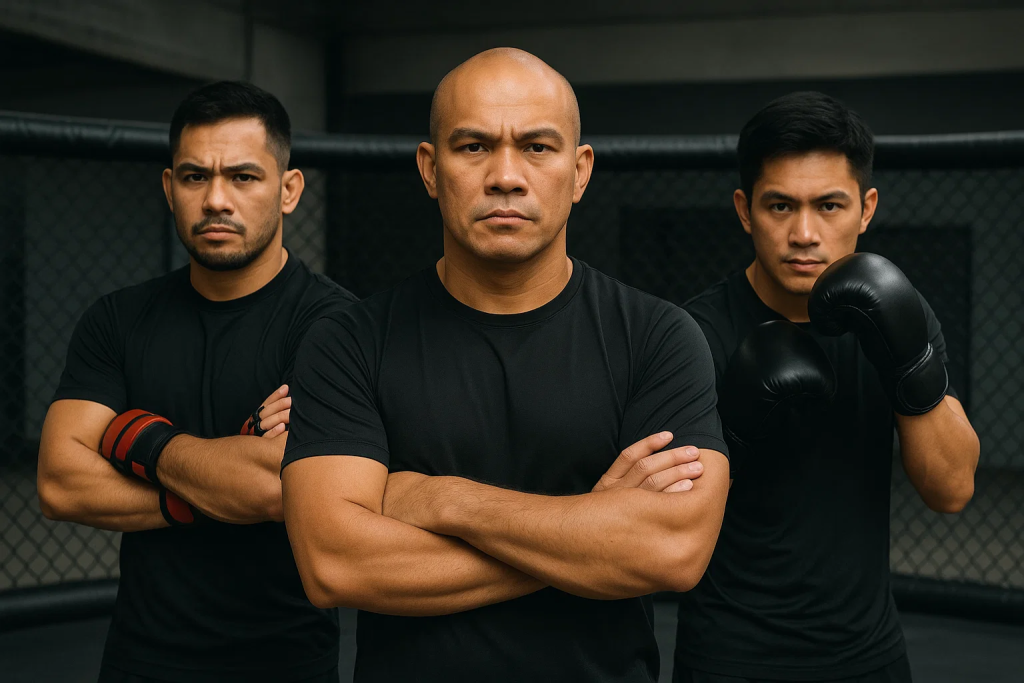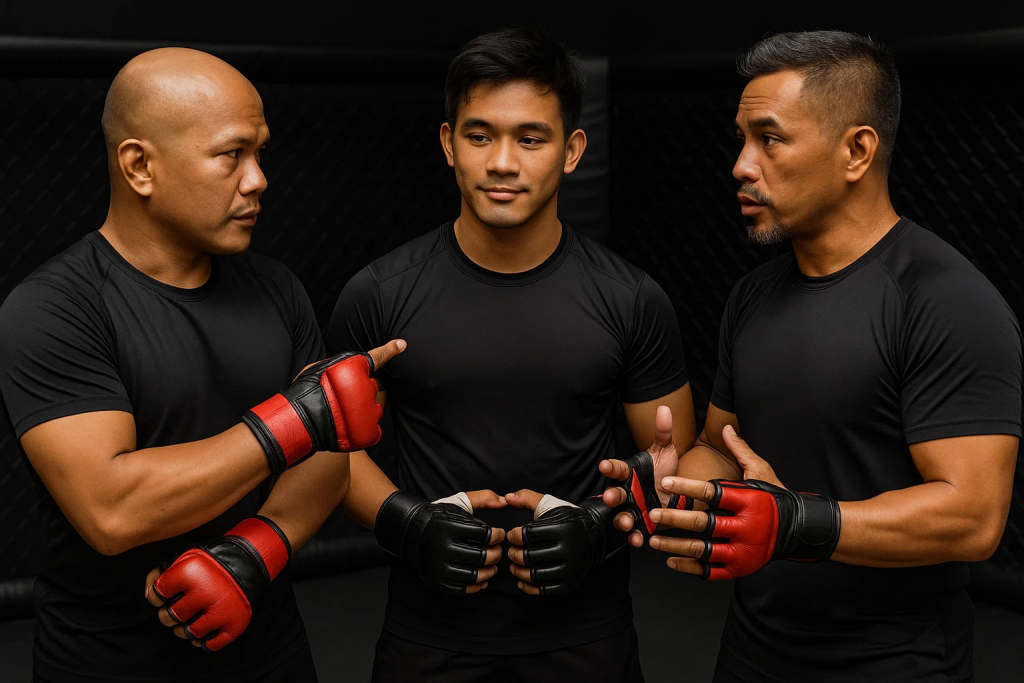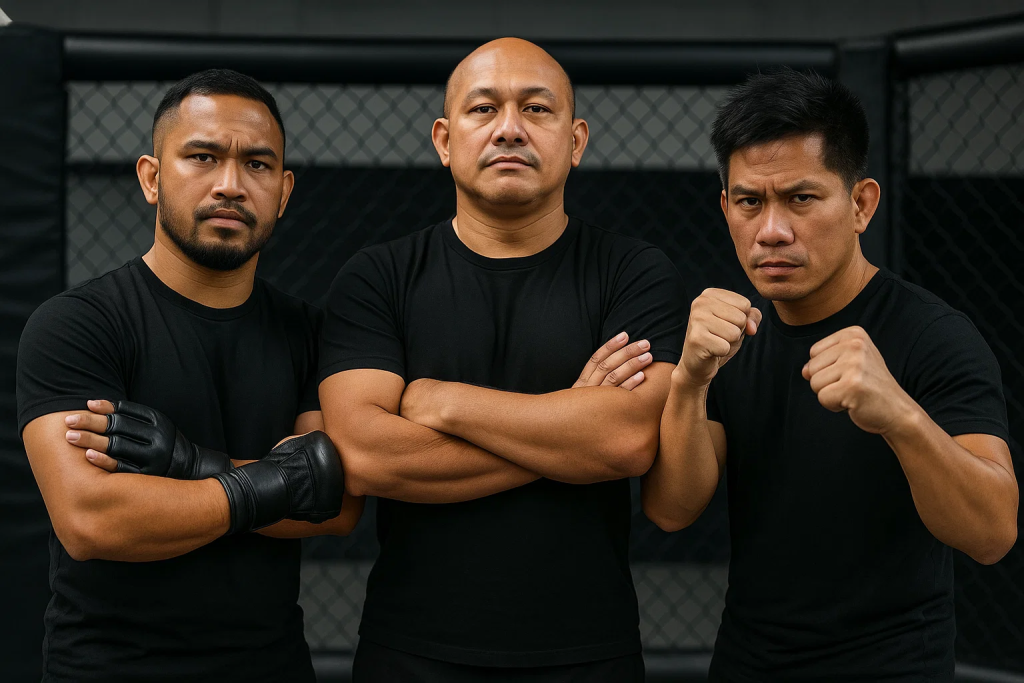Table of Contents
Why “Bedrock” Beats Hype in Philippine MMA
Ask the most respected Philippine MMA coaches—from Manila’s sweatbox gyms to Cebu’s coastal academies—what separates stayers from faders, and you’ll hear one word: systems. Talent flashes; systems compound. Bedrock principles protect your brain and joints, shorten the learning curve, and let you scale from hobby rounds to regional main events.

“Bedrock” means you master the positions that repeat the most under stress: stance, footwork, head position, base, frames, hand-fighting, cage pummeling, and safe exits. You layer conditioning that actually transfers to the sport (alactic bursts, repeated efforts, isometric wrestling). You plan the year (or 12-week camp) so you peak on fight night—not at a Tuesday hard spar. You sleep, eat, and breathe like results depend on it—because they do. And you measure a few things relentlessly: takedown efficiency, cage-escape time, strike differential, and heart-rate recovery.
Below is the definitive, practical blueprint—written for Filipino fighters, coaches, and serious hobbyists—built around those bedrock principles.
Principle 1: MMA Stance, Footwork, and Range Control Are Non-Negotiable
What coaches stress
- Neutral, athletic stance you can strike, shoot, or sprawl from. Rear heel light, chin tucked, shoulders relaxed.
- Four-direction footwork (forward/back/left/right) with hips under you; no crossing feet when pressured.
- Range literacy: long (probe), mid (score), short (clinch or burst). Win the inches first; combos come later.
Drills that work
- Line walk, ladder & cone arcs (5–8 min blocks) focused on braking and re-acceleration—not just speed.
- Shadow rounds with constraints: “jab only,” “only single kicks,” “exit right after every 1–2.” Constraints hardwire good habits.
- Mirror tag: partner mirrors you in a 3×3 m square; goal is to “touch” glove without being touched—teaches deceptive footwork and range.
Common errors & quick fixes
- Tall, stiff stance → add knee bounce and hip hinge; imagine a spring.
- Crossing feet under fire → cut angle with a “T-step” (rear foot lands outside opponent’s lead).
- Reaching with punches → step first, then punch; or pivot to change the line.
Principle 2: MMA Defense First—Head Position, Guard Recovery, Safe Exits
You can’t develop if you’re constantly dinged. Filipino coaches build defensive layers before they ramp offense.
- Head off the center line after every strike; slip-and-seal (hands home).
- Frame-to-exit habit: stiff arm on chest/shoulder → sidestep → reset stance.
- Cage-walk recoveries as a warm-up staple: learn to get up clean, without giving your back.
Metrics to track weekly
- “Clean rounds” (no head-shot damage landed on you).
- Average exit time from the pocket after initiating a combo (subjective 1–3 rating is fine).
- Mat return prevention rate (how often you stand and stay up after first attempt).
Principle 3: MMA Layered Skill Acquisition—From Isolated to Chaotic
Good coaches teach like engineers: isolate → pressure → integrate.
- Isolate: jab feint to level change without a partner.
- Add pressure: partner sprawls/knees/underhooks.
- Integrate: same sequence with fence, live counters, and a scoring goal (e.g., secure body lock or break and score).
Session template (60–75 minutes)
- 10’ movement prep (mobility + stance footwork)
- 15’ isolated skill (A)
- 15’ pressured responses (A → partner choices)
- 15’ integration round (with fence and scoring)
- 10’ cool-down breathing + note your one improvement
Principle 4: MMA Situational Sparring > Unstructured Wars
Technical IQ grows when sparring is position-rich and ego-light.
- Start rounds in trouble: back on fence, bottom half guard, over-under at the wall.
- Control intensity with the round theme: 60–70% for learning blocks; brief 80–90% touches in camp.
- One weekly hard touch (or none outside camp) with headgear, clear rules, and coach on the whistle.
Coach cue: “We’re sparring the situation, not each other.”
Principle 5: MMA Wrestle Box—Where Most Fights Are Won
Filipino coaches blend boxing entries with wrestling finishes so you can touch, change level, and finish.
- Boxing to double: jab to draw parry → cross to hide level change → step-in double to shelf.
- Fence series: underhook → head position to ear → knee tap or body-lock switch.
- On the break: hand fight, shoulder nudge, exit hook or calf kick to score.
KPIs
- Takedown conversion (% finishes / attempts) per partner tier.
- Second-step discipline (did you drive after initial contact?).
- Break-and-score rate (points landed after exiting clinch).
Principle 6: MMA Grappling Bedrock—Base, Frames, and Two-Move Chains
- Base = balance under fire. Drills: hip heist, technical stand-up, tripod get-up, knee-slide escapes.
- Frames = breathing room. Inside biceps, collarbone, hip bone—teach where frames live and how to replace them.
- Chains = choice. Example: single-leg to shelf; if they whizzer hard → knee tap; if they sprawl → switch to body lock.
30-second micro-scrambles
Timer buzzes every 30s; coach calls start positions (half guard bottom, turtle, seatbelt); score is escape/retain/submit. This builds scramble literacy without silly chaos.
Principle 7: Conditioning That Transfers—Alactic Power, Repeatability, Isometrics
What carries to the cage
- Alactic power (0–10 s): short hill sprints, heavy sled pushes, med-ball heaves—full rest between efforts.
- Lactic repeatability (20–90 s): assault bike or bag blitz intervals with incomplete rest to mimic surges.
- Isometric wrestling: wall pummeling holds, towel pulls, neck isometrics (progressive, coached).
- Cardiac base: 30–40 min zone-2 (nasal breathing pace) for recovery and durability.
Two-day sample
- Day A: 8×6-sec hill sprints (walk-back rest); 3×6 med-ball chest passes + 3×6 rotational throws; finish with 15’ zone-2.
- Day B: 6×40 s bike @ hard; 80 s easy between; 3×30 s wall pummeling holds; 10’ mobility.
Principle 8: MMA Periodization—Programming Beats Random Grind
You can’t redline all year. Filipino coaches run blocks that cycle stress and build toward fight night.
Example 12-week camp
- Weeks 1–3 (Base/Build): technique volume, strength base, zone-2; situational sparring light.
- Weeks 4–7 (Integrate): chain wrestling, wrestle box, lactic repeats, positionals every session.
- Weeks 8–10 (Sharpen): less volume, more intensity; game-plan drilling; one hard spar touch weekly.
- Weeks 11–12 (Taper/Fight): intensity “touches,” weight on track, CNS fresh; tech spar only.
Weekly rhythm (pro example)
- Mon Striking + alactic; Tue Grappling + isometrics; Wed Situational spar + base; Thu Strength/Power; Fri Integration + repeats; Sat Technical spar + video; Sun Off or 30’ recovery.
Principle 9: MMA Recovery, Sleep, and Mobility Are Training
You adapt between sessions, not during them.
- Sleep 7–9 h with consistent bedtime; cool, dark room.
- Mobility 10–12 min daily: hips (pigeon/90-90), T-spine (open books), ankles (knee-to-wall), plus diaphragmatic breathing.
- Active recovery: nasal walks, easy swims, skipping rope at talkable pace.
- Red flags: morning HR up >8–10 bpm from baseline, poor mood, dead legs—dial volume down.
Principle 10: MMA Nutrition & Weight—Start Early, Cut Smart
Guidelines (general, not medical advice)
- Stay within 8–10% of your class year-round.
- Protein 1.6–2.2 g/kg/day, spread over 3–5 meals.
- Carbs scale to training day (more on hard days).
- Hydrate to pale-yellow urine; add electrolytes in heat/humidity.
- If cutting, plan months out with a qualified pro; no extreme dehydration or risky diuretics.
Fight-week pointers
- Keep fiber moderate, sodium steady unless instructed by your professional team.
- No novel supplements. Sleep more; stress less.
Principle 11: Game Planning—Script the Fight You Want
Coaches write simple, executable plans with A- and B-scripts and a few cue words.
- Three win conditions: e.g., calf-kick score + cross; fence control & knee taps; exit right to counter hook.
- If-then trees: if opponent checks calf kicks → body jab to clinch; if they pummel double underhooks → head position to ear, knee tap.
- Rehearsal under fatigue: simulate crowd noise; coach calls disruptions mid-round.
Cue words
- “Chin & hands”—chest level hands, chin tucked.
- “Head off line”—slip or step on every entry.
- “Break & score”—don’t admire your work; exit with a shot.
Principle 12: Track What Matters—Small Dashboard, Big Gains
Pick 4–6 KPIs you can measure weekly:
- Significant strike differential (landed vs. absorbed).
- Takedown efficiency (finishes/attempts) by partner tier.
- Cage-escape time (seconds to build base & separate).
- Top control time (retention in grappling).
- Heart-rate recovery (beats dropped in 60 s post-round).
- Sparring IQ (coach’s 1–3 score on decision quality).
Commit to one improvement per week. Tiny deltas compound.
The MMA Amateur’s 8–10-Week Blueprint (3–4 Sessions/Week)
Week 1–2: Fundamentals Lodge
- 2 skill days: stance/footwork, jab feints, calf-kick defense, technical stand-ups.
- 1 grappling day: hip heist, get-up chains, single-to-body-lock.
- Optional base day: 30–40 min zone-2; 10 min mobility.
Week 3–4: Add Pressure
- Situational spar begins: 6×3’ rounds starting in trouble.
- Introduce alactic sprints (6-sec × 6–8).
- Track cage-escape time and clean rounds.
Week 5–6: Integrate
- Wrestle box flow; fence pummeling every session.
- Lactic repeats 1×/week (bike or bag 30–40 s on, 80 s off).
- Film 2 rounds; write one strength, one fix.
Week 7–8(–10): Sharpen & Taper
- One technical spar touch weekly; keep brains safe.
- Rehearse openers & exits.
- Fight week: reduce volume, keep timing, sleep more.

The MMA Pro’s 12-Week Camp (Deep Dive)
Weeks 1–3—Base/Build
- Volume on technical reps; heavy emphasis on range literacy, cage get-ups, zone-2 base, total-body strength.
- KPI: HR recovery improves 5–10 beats in minute one.
Weeks 4–7—Integrate
- Chain wrestling every practice; wrestle box combos; situational rounds from fence & bottom.
- Add lactic repeats (bi-weekly).
- KPI: takedown efficiency up; escape time down.
Weeks 8–10—Sharpen
- Game-plan scripts A/B; one controlled hard spar weekly.
- Micro-tapers around heavy sessions; keep sleep non-negotiable.
Weeks 11–12—Taper
- Intensity touches; volume low.
- Final weight check, logistics, walkout, and cue cards.
- KPI: feel fast, springy, calm.
Mistakes Filipino Coaches See—and How to Fix Them
- Highlight hunting (fancy stuff before basics) → Put 10 minutes daily on stance/footwork and fence get-ups.
- Random “hard” days → Follow a plan with high/medium/low days.
- Too many wars → Situational spar; protect your brain.
- Late weight panic → Stay within 8–10% of class; plan months ahead.
- Copying pros → Train for your job, sleep, age, and recovery.
Nutrition That Fighters Actually Follow
- Protein anchor each meal (eggs, chicken, fish, tofu, lean pork/beef).
- Color rule: two colors of veg at main meals.
- Carb timing: more around hard practices (rice, potatoes, oats, bread you digest well).
- Hydration: sip all day; add electrolytes if drenched.
- Travel kit: shaker, portioned oats, nut packs, jerky, electrolyte tabs—so airports don’t derail you.
Mindset: The Invisible Bedrock
- 3-minute pre-round ritual: breathe (4-6 slow exhale cycles), cue words, first action.
- Process framing: evaluate “Did I execute my cue?” rather than “Did I win the round?”
- Film without fear: look for opponent habits (hands drop on exit, shoots when hurt), not highlight intimidation.
- Team language: short calls everyone understands—“head on chest,” “pummel left,” “break and score.”
Video & Data on a Budget
- Phone + tripod; shoot from side and at fence.
- Tag simple data: round time, start position, result (escape/retain/score).
- One-page weekly: strike differential, TD % by partner tier, average escape time, one strength/one fix.
- Iterate: change only one variable per week.
Choosing the Right Gym in the Philippines
- Safety culture: clear spar rules, mouthguards, shin guards, first-aid kit visible.
- Coaching depth: striking, wrestling, jiu-jitsu coaches who coordinate, not compete.
- Beginner track: structured fundamentals classes.
- Hygiene: clean mats, posted cleaning schedule.
- Community: teammates who help you get better, not just tougher.
Fight Week—What Coaches Actually Do
- Trim, don’t build: no new tech; maintain timing.
- Rehearse openers both ways (on offense / under pressure).
- Light positional grappling; no neck-cranks or big slams.
- Logistics check: wraps, mouthguard, ID, weigh-in kit, recovery snacks, cue card.
- Environment control: sleep earlier; breathe often; keep screens low after sundown.
A Sample 7-Day Micro-Plan You Can Use Next Week
Day 1 (Mon): Striking fundamentals 40’; wrestle box entries 20’; alactic sprints 8×6 s; mobility 10’.
Day 2 (Tue): Chain wrestling 40’; fence pummeling 20’; zone-2 25’.
Day 3 (Wed): Situational spar 6×3’ (start back-to-fence); bag tech 15’; cool-down walk 10’.
Day 4 (Thu): Total-body strength 40’; med-ball throws 12’; breathing 8’.
Day 5 (Fri): Integration rounds 30’; lactic repeats 6×40 s bike; mobility 10’.
Day 6 (Sat): Technical spar 45’; film review 15’.
Day 7 (Sun): Off or 30’ nasal walk + hips/T-spine 10’.
KPI focus: takedown efficiency and cage-escape time this week. Improve one; maintain the other.
Use these in headings, image captions (e.g., “pummeling drill at the fence”), and internal subheads. Keep language human—keyword stuffing kills trust and rankings.
Strong Call-to-Action
Fighters, coaches, serious hobbyists: drop your experience level (beginner, amateur, pro), your biggest bottleneck right now (e.g., “can’t escape the fence,” “gassing in Round 2,” “fight-week nerves”), and how many sessions you can train next week. I’ll reply with a personalized 7-day micro-plan—drills, conditioning targets, and one KPI to track—so you can apply these bedrock principles immediately.
Final Word
Great Philippine MMA camps aren’t built on hype—they’re built on bedrock. When stance, footwork, defensive shapes, and chain wrestling are second nature—when conditioning matches the sport—when periodization, sleep, and nutrition are non-negotiable—and when a clear game plan meets simple KPIs, you don’t just look like a fighter, you become one. Start small this week: fix one stance detail, master one escape, add one alactic block, and track one KPI. Stack those wins and the results will multiply.

Frequently Asked Questions (FAQ)
1) How many days per week should a beginner in the Philippines train MMA?
Start with 3–4 days: two skill-heavy sessions (striking and grappling), one situational spar day, and one recovery/base day. Consistency beats heroics. Add volume only when your sleep, mood, and heart-rate recovery say you’re adapting.
2) Do I need hard sparring to get fight-ready?
You need contact exposure, not weekly wars. Filipino coaches favor technical and situational sparring with protective gear and controlled intensity. Schedule any hard touches inside a camp, keep them coach-refereed, and prioritize brain health all year.
3) What conditioning should I choose if I only have 30 minutes?
Alternate alactic power (6–8 s sprints, heavy med-ball throws) with lactic repeatability (20–60 s bike or bag intervals). Pair each with a short skill block so conditioning reinforces technique. Add zone-2 on another day for recovery.
4) How far from fight weight should I be in the off-season?
Stay within 8–10% of your class. The closer you are, the less risky fight-week becomes. Plan early; prioritize protein, smart carbs around training, and steady hydration. Use qualified professionals for any cut—avoid extreme dehydration tactics.
5) What single KPI should I track first?
Pick one that aligns with your style.
Wrestlers: takedown efficiency and cage-escape time.
Strikers: significant strike differential and HR recovery in the first 60 seconds after a round.
The best KPI is one you can measure weekly and move by deliberate practice.
